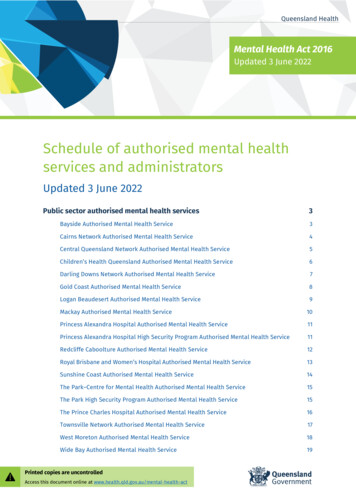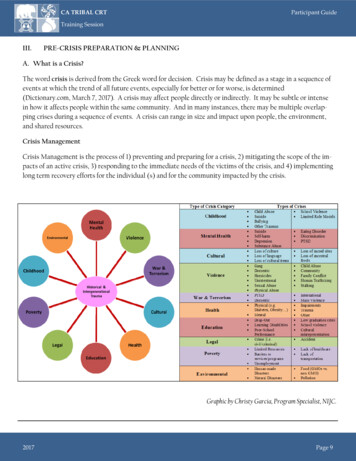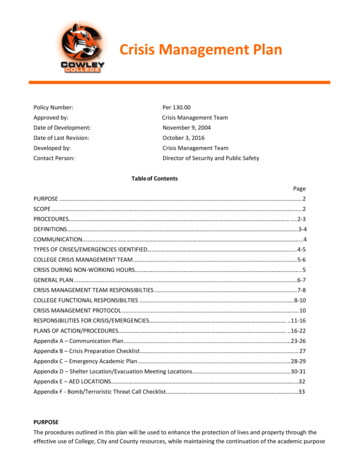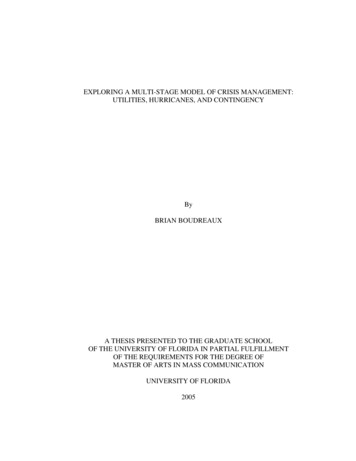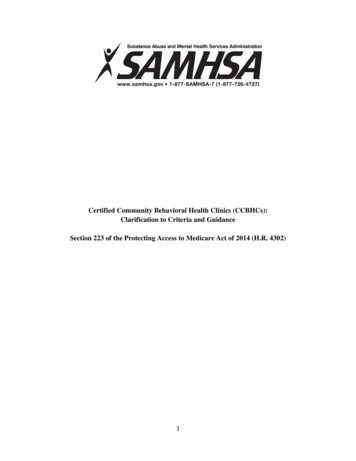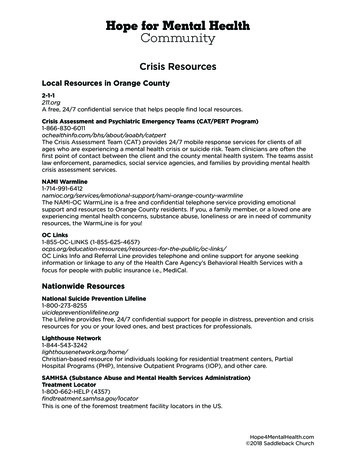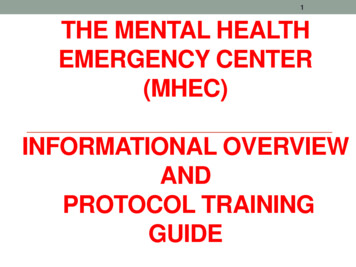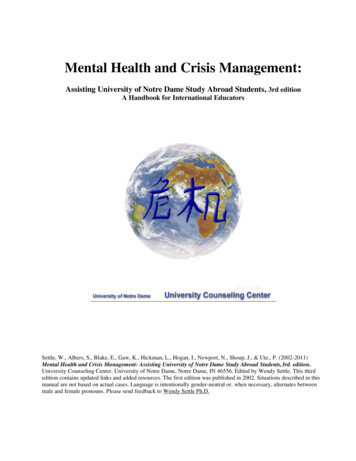
Transcription
Mental Health and Crisis Management:Assisting University of Notre Dame Study Abroad Students, 3rd editionA Handbook for International EducatorsSettle, W., Albers, S., Blake, E., Gaw, K., Hickman, L., Hogan, I., Newport, N., Shoup, J., & Utz., P. (2002-2011)Mental Health and Crisis Management: Assisting University of Notre Dame Study Abroad Students,3rd. edition.University Counseling Center, University of Notre Dame, Notre Dame, IN 46556. Edited by Wendy Settle. This thirdedition contains updated links and added resources. The first edition was published in 2002. Situations described in thismanual are not based on actual cases. Language is intentionally gender-neutral or, when necessary, alternates betweenmale and female pronouns. Please send feedback to Wendy Settle Ph.D.
Mental Health and Crisis Management:Assisting University of Notre Dame Study Abroad StudentsIntroduction . 2Section IMental Health and Issues and Disorders: What You Need To Know. 3The Study Abroad Student and Culture Shock . . . 4Helping the Study Abroad Student who is Depressed or Suicidal . 10Assisting Study Abroad Students with Eating Disorders . 15Assisting the Study Abroad Student Dealing with Grief and Mourning . 19Students Studying Abroad who Abuse Alcohol. 23Assisting the Study Abroad Student who has been Raped or Sexually Assaulted 27Sexual Harassment and Notre Dame Students Studying Abroad . 33Reentry and Reverse Culture Shock: Helping the Study Abroad StudentTransition Back Home . 40Section IIInternational Educator Challenges and Dilemmas . 46Tips for Identifying, Assisting, and Referring Students in Distress 47Consulting with the University Counseling Center . 51Assisting the Notre Dame Study Abroad Student Who Needs to Withdraw . 52Section IIIResources for International Educators on the Internet . 53University of Notre Dame Offices and Contacts .Mental Health Crisis Management Resources Mental Health Crisis Management Resources for International Educators .Sources for Articles on Mental Health for International Educators . .53545556About the Authors . 571
IntroductionSusan Steibe-Pasalich , Ph.D.UCC DirectorUniversity Counseling CenterUniversity of Notre DameOver the years, the staff of the University Counseling Center has been directly and indirectlyinvolved with Notre Dame's Office of International Studies. When students return from theseprograms, they often contact us to talk about some of the difficulties they experienced whileoverseas or upon returning to Notre Dame. We also have had Directors, faculty, residence staff,international and on-campus administrators call us to seek consultation about individual studentswith problems or concerning conflicts among students.When it was suggested that we prepare some materials for the staff of our International Programs,we saw this as an opportunity for us to take a preventive approach to these problems. We are hopingto describe some of the situations you can expect during a student's time in the program, providesome general information about typical problems and offer some suggestions for ways that youmight intervene.This handbook has been written to assist the International Study Programs’ On-Site Directors,Associate Directors and staff to deal with problems of students as they develop. Staff are notexpected to be counselors or psychologists to the students. However, having some basic notionsabout the nature of typical problems college students face along with some "do's and don'ts" can beuseful in crisis situations.Crisis "Danger and Opportunity"2
Section IMental Health Issues and Disorders:What You Need to KnowAs you are well aware, study abroad can be a personally rewarding, culturally expanding, growthproducing -- as well as a somewhat stressful -- experience. Almost one-tenth of the student body atNotre Dame seeks services from the Counseling Center for issues related to personal growth, inaddition to depression, anxiety, grief and loss, family problems, interpersonal relationships, eatingdisorders, problems with alcohol, and sexual abuse, to name a few. Most Notre Dame students areyoung adults going through the usual emotional ups and downs of college life. Some navigate morestressful and unusual transitions into adulthood, causing them to feel alone and apart from theirpeers. Students do not necessarily leave their stresses at home when they come to study abroad,which may leave you, as the international educator, assuming that you must take care of all of theirissues on your own. To some extent, you are assuming responsibility, probably more than any onehuman could be trained to provide. We hope that as you read this document, you will learn that youhave more support and resources than you previously realized, so that you do not need to bear theburden of dealing with students' crises completely on your own.It is also helpful to realize that sometimes what seems to be a crisis to the new study abroad studentis actually a normal developmental phase of adjustment, typically called "culture shock." We followour chapter on culture shock with descriptions on how to talk to students who are dealing with whatcould be more severe or chronic disorders and stresses. These include helping students who aredepressed/suicidal, showing signs of eating disorders, or dealing with grief and loss, alcoholproblems, sexual harassment, assault and rape. If you are concerned about a student, you are notexpected to "diagnose" culture shock versus other, more severe issues. However we do believe thatthe more you know, the more you will be able to distinguish when a student may need interventionfrom a local mental health specialist and/or intervention in consultation with another specialist atUniversity of Notre Dame, such as from within Student Affairs. Wendy Settle, Ph.D.3
The Study Abroad Student and Culture ShockKevin F. Gaw, Ph.D.PsychologistCounseling & Testing CenterUniversity of Nevada, RenoIntroductionCulture shock is not a psychological disorder, but in fact, it is a developmental phase that is bothcommon amongst sojourners and expected when one adjusts "properly" in a cross-cultural context. Itis important to recognize culture shock since the symptoms can mimic more severe psychologicaldisorders, such as depression. In addition, as an international educator, your role in assisting studentsto adjust to the new culture will help to prevent the development of psychological problems. Thischapter describes culture shock and the common signs of the experience. In addition, approacheswill be suggested on how to help your students adjust and work through the experience and how youcan use the adjustment phase as an opportunity for the development of your students' interculturalsensitivity.What is Culture Shock?While there are many academic definitions of culture shock, the experience can be simply describedas a clash between one's personal way of viewing and interacting with the world (which isdetermined by one's home culture) and the new cultural environment. This is the classic conflictbetween ethnocentric and ethnorelative views of the world, which is experienced as a perceived lackof control or a sense of helplessness. Anxiety, frustration, confusion, loss of perceptual cues,discrepant meaning systems - all these contribute to the "clash."Culture shock has often been described as an adjustment cycle, with an initial high point upon entrymarked by excitement and optimism, a low point during the sojourn (the culture shock phase), and amoderated "high point" near the end of the sojourn experience as the student learns to function moresuccessfully. "W-Curve" model (Gullahorn and Gullahorn, 1963) is frequently cited because itdescribes not just the initial culture shock stages (Excitement, Disillusionment, Confusion, andPositive Adjustment), but replicates a similar adjustment cycle for reentry "back home." Whilereentry might seem a non-issue, in fact, it is often experienced as more stressful than initial cultureshock.Culture shock is about a student’s struggle in becoming culturally competent in a new culturalenvironment, where the rules, behaviors, expectations, food, language, and systems are all differentfrom home. Culture shock is perfectly natural. When a person struggles through such a challenge,the person grows; they mature. Evidence demonstrates how study abroad students, when theyapproach their experiences in a developmental manner (that is, they intend to learn and grow as aperson from their overseas experience), they develop psychologically and socially. Positive changesin attitudes, behaviors, global awareness, worldviews, values, cultural understanding and empathy,and ethnorelativism, have all been documented. Many times when a student is experiencing cultureshock, no intervention is needed because it is natural and developmental – a capable, self-aware,interested student will work through the experience.4
Some researchers have indicated culture shock lasts for a few weeks, while others have documentedlonger time frames, including over a year. Still, other researchers have found that culture shockseems to be proportionate with one's sojourn time frame. Because culture shock is a developmentalprocess within the adjustment cycle, the time frame is individualized and depends upon the student'sresources (internally and externally). For the high functioning, mature, curious, flexible (these seemto be critical variables) young person, culture shock typically resolves itself within six months orless.The bottom line is this: culture shock appears to be a process of experience. With time, support,learning and mindfulness, it can become a positive developmental experience, much like how wethink it’s good for our teenagers to leave home and "go out into the world" to become responsibleyoung adults.Is Culture Shock Always "Painful?"This is an interesting question, as some sojourners seem to adjust with relative ease while othersreally struggle. What seems to make the favorable difference for many is their openness to culturaldifferences, readiness for change/growth, and tolerance for ambiguity and stress. For others, theymay have a predisposition for some sort of disorder, and the stress of adjustment may bring this out.Culture shock can be exacerbated when a student is isolated or isolative. However, a difficultadjustment does not mean the student is in trouble; it may simply mean they are encountering a lot ofchallenges and a lot of questions. Support and assessment are essential.Depression, discussed in the next chapter of this handbook, sometimes arises from culturaladjustment. Culture shock itself is not depression, though some of the signs mimic depression (seeTable 1). What is important to watch for is if the student has the potential for depression; if so, thenculture shock might bring the depression forward. The same can be said about substance abuse,eating disorders, anxiety disorders, or other difficult presentations. It is very important, though, toseparate the adjustment data from more "clinical" data to avoid errors in labeling. Whenever indoubt, do what a competent mental health clinician does: consult!Recognizing Culture ShockTable 1 lists the more common signs of culture shock; the list is not complete but an introduction. Itis fairly common for the "shocked" student to not even recognize culture shock because the studentcan "rationalize" the signs. Look for clusters, patterns, and behavioral changes; use the feedback ofothers who know the student. Remember that culture shock by itself is a normal part of theadjustment cycle to a new cultural environment.5
Table 1. Some Emotional and Behavioral Signs of Culture ShockEmotional Signs al SignsAlienation No friends"Self-imposed" isolation Limited intercultural skilldevelopmentAnger Acting out (physical, verbal)Excessive drinkingEthnocentrism DefensivenessComplaining about the hostculture/people IsolationWithdrawal (social,academic) Discontinues pleasurable activitiesWriting or calling home a lotAnxiety NervousnessTension (muscles, "nerves")Insomnia Poor concentrationFear of being misunderstoodApathy Regressive behaviorsSocial and academicwithdrawal Lack of care for self/othersPoor personal hygieneConfusion JudgmentalStereotypingCommunication problems Poor decision makingQuestioning Self (identity, role,purpose)Depression InsomniaSubstance abuseWeight changeAppetite change Social/Academic withdrawalEmotional swingsIrritability/AngerDecline in self-care no appropriate risk takinghand-washing, clothesavoidance ee the Depression chapter)Obsessions injuryinadequaciesnot being ulsions compensationacting out behaviorswithdrawal, defensive6
Providing Support as Students Adjust through the Stages of Culture ShockThe kind of support you provide will differ across students, as their culture shock is different.Perhaps one of the greatest forms of support is to listen in a manner that validates the student’sexperience without solving their challenges for them (how else will they discover theircompetency?). Be comfortable with the expression of feelings – as there really is no such thing as a"good" or "bad" feeling – feelings just are feelings, and they give us good data on what’s going onwithin us. Strong affect is OK too, as long as it’s respectful of self and others. Below are someimmediate ideas on support.Basic Listening: While this may seem really obvious, using basic listening skills will go a long wayin supporting a student. Basic skills are attending, reflection, asking questions, and summarizing. Tryto use the student's words rather than your words to frame their experience. Validate experience;avoid the temptation to problem solve.Journaling: Reflective writing has served as a productive "refuge" for many, allowing them togather thoughts and feelings in one safe place. Journaling does require reflection for it to be useful.Encourage students who journal to talk about their reflections (not necessarily the actual content ofwhat’s written). Some students also write poetry, draw or paint as other forms of creative expression.Much of culture shock revolves around not connecting to (or fitting into) the host environment;questions and reflections should address these issues.Field Trips: Design excursions that progressively allow students greater and greater autonomy, ifyour program has some control of this. Use trips to deliberately monitor how students interact withhosts and the environment; then promote skills acquisition based on assessed areas of competencies(e.g., language, systems knowledge, cultural knowledge, behavioral cues). This could be donethrough many approaches, such as an orientation class/program, a Talking Circle, or evenindividually.Talking Circle: One approach to providing support is to allow your students and you to gather as aprocess group to talk about experiences and what's been discovered of the new environment. Thisnurtures the growthful aspects of culture shock and spreads the responsibility (and dynamics) ofsupport to a network of peers. It is important the group avoids bashing the host environment, for thismerely reinforces ethnocentrism, one of the keys to remaining locked in bitter dispute with one’ssituation."Mentors": If your program allows pairing more seasoned students with newly arrived students,this could be helpful, but only for short-term contact. New arrivals want to feel a sense of masteryand having an "old hand" showing them around does convey a message that the new arrival needs"baby sitting." Instead, design short-term contacts, such as one-day tours to generally introduce the"lay of the land," yet refrain from teaching the subtleties of the new environment. This might helpprevent conveying a message of inadequacy, one of the culture shock themes. Conversely, insituations that require interventions, a more experienced sojourner may be the ticket because he/shecan cut to the chase and the distressed student will likely trust their experience.7
Cultural Mediator: One reason why people experience culture shock is that they feel overwhelmedby all the new things in the host environment. The cultural mediator's role promotes bothintercultural exchange and competencies. However, be mindful to design the use of a mediator sothat it tapers off so as to intentionally increase your students’ competencies. Cultural mediators arealmost always trusted "locals" who are sensitive to your students' needs and the student experience.Identity: It is very important for individuals to have a sense of self – an identity. Sojournexperiences tax our identities beyond belief. Allow students to convene, to share experiences, tohave a sense of national, ethnic and personal selves, to re-establish connection with Notre Damethrough you and the program. Also allow for students to have personal time. No one expects aperson to lose his or her identity to become "multicultural." In fact, to be really multicultural, onemust start and end with oneself.ConclusionCulture shock is developmental and appropriate - it means a student is wrestling with culturaldifferences and trying to make sense of those differences. If the student remains in conflict, they maybecome "stuck" and experience depression, social problems, or even academic problems. Workingthrough culture shock usually results in stronger, more interculturally competent students who arecapable of resolving the daily stresses of living in a different country and culture. Perhaps one of thegreatest joys as a country director is to be a part of this exciting (and challenging) growth experienceof your students.Selected Reference ListBennett, M. J. (Ed.) (1998). Basic concepts of intercultural communication. Yarmouth, ME:Intercultural Press. 1Gaw, K. F. (2000). Reverse culture shock in students returning from overseas. InternationalJournal of Intercultural Relations, 24, 83-104. 2Kauffmann, N. L., Martin, J. N., & Weaver, H. D. (1992). Students abroad: Strangers athome. Education for a global society. Yarmouth, ME: Intercultural Press. 1Lewis, T. J., & Jungman, R. E. (Eds.). (1986). On being foreign: Culture shock in shortfiction: An International anthology. Yarmouth, ME: Intercultural Press. 1Paige, R. M. (Ed.). (1993). Education for the intercultural experience (2nd. ed.). Yarmouth,ME: Intercultural Press. 1Ryan, M. E., & Twibell, R. S, (2000). Concerns, values, stress, coping, health andeducational outcomes of college students who studied abroad, International Journal ofIntercultural Relations, 24, 409-438. 28
Sorti, C. (1990). The art of crossing cultures. Yarmouth, ME: Intercultural Press. 1Zapf, M. K. (1991). Cross-cultural transitions and wellness: Dealing with culture shock.International Journal for the Advancement of Counseling, 14, 2http://library.nd.edu/9
Helping the Study Abroad Student who is Depressed or SuicidalWendy Settle, Ph.D.PsychologistUniversity of Notre Dame Counseling CenterImagine this scenario. You notice that one of your students in your study abroad program isn'tspending as much time with her friends, preferring to stay in her room. She appears sad but alsoirritable, which alienates people. She's picking at her food and complaining that she isn't sleepingwell. Whereas she used to be enthusiastic about her classes and learning the new culture, now she'slost interest. She's not concentrating well and would rather sleep in than go to class. The others in theprogram have moved on to become more adjusted but she has continued to feel depressed now forseveral weeks.Are these symptoms a continuation of the normal process of cultural adjustmentor clinical depression?As previously described, the symptoms of "culture shock" are very similar to the symptoms ofdepression. Students normally go through a period of adjustment which can include symptoms suchas anxiety, sadness, depression, lack of energy, headaches, anger, confusion, despair, changes ineating and sleeping habits, loss of interest in activities, frustration, and loneliness. This adjustmentphase is normal and occurs for a short period of time.When might these symptoms be indicators that the student is clinically depressedand needs a referral for an assessment?You may suspect that a student is "clinically depressed" and needs immediate intervention if thestudent has had symptoms for a prolonged period of time (several weeks), and is unable to function(e.g., not going to class, isolating). Immediate intervention is warranted if the student shows selfdestructive or violent behaviors, or is also abusing alcohol or substances. Depression usually beginsin adolescence or early adulthood, and is very common in college age students. Types of clinicaldepression include major depression, dysthymia (persistent mild depression for two years), seasonalaffective disorder, and bipolar disorder (moods swing from depression to grandiose, energetic,possibly irritable, abnormal "highs"). People with major depression often suffer with the followingsymptoms, which are significantly impairing their personal or academic functioning: Change of appetite; significant weight loss or gainChange in sleeping patterns, such as fitful sleep, inability to sleep, early morningawakening, or sleeping too muchLoss of interest and pleasure in activities formerly enjoyedLoss of energy; fatigueFeelings of worthlessness or hopelessnessFeelings of inappropriate guilt10
Inability to concentrateRecurring thoughts of death or suicideWithdrawing from social interactionsPhysical symptoms, such as headaches or stomachachesNot everyone who is depressed experiences every symptom. Symptoms and their severity vary witheach individual case of depression, and sometimes symptoms are not caused by depression but maybe due to a general medical condition, such as problems with one's thyroid.How do I refer a student who is depressed for an evaluation and/or treatment?Students who are depressed should be referred to a local mental health practitioner, a psychiatrist, ora physician for an evaluation. Please note that in some countries (e.g., the U.K) a referral to a mentalhealth practitioner must be made by a medical physician, and in other countries a mental healthpractitioner must make the referral to a psychiatrist. Consult your local embassy to learn aboutreferral procedures in your country and to obtain sources for referrals. Ask the student to sign thepractitioner's release of information form so that you may consult with the practitioner to obtainhis/her recommendations. Fortunately, once diagnosed by a qualified professional, depression iseasily treated. About 80-90% of people who seek treatment for depression respond well to treatment,which usually consists of a combination of therapy and antidepressant medication. It is possible in afew cases that treatment may be able to be handled locally on an outpatient basis if the depression ismild and intervention is begun early. After the student has begun treatment, or if the student'sdepression is evaluated not to be severe enough for treatment, refer the student to self-help resourcesto alleviate their feelings of sadness (refer to the web sites listed below). Continue to provide supportbut do not attempt to provide treatment yourself. If the student's depression is moderate to severe, oris significantly impacting the student's cultural adjustment and/or academics, you will most likelycounsel the student to go home for treatment. These decisions can be made through consulting withthe student's local mental health practitioner or physician.What if I suspect that a student is suicidal?Studies show that depression underlies the majority of suicides. Suicide is the third leading cause ofdeath among Americans aged 15-24. One of the best strategies for preventing suicide is earlyrecognition and treatment.Eight out of ten people who commit suicide give overt or covert warnings that they are consideringsuicide. The student may make verbal hints or jokes, such as "You won’t have to worry about meanymore," or "I want to go to sleep and never wake up," or "Does God punish suicides?" or "Voicesare telling me to do bad things." The student may give away possessions, write emails, instantmessages, chat, or make skype or telephone calls to people to "say goodbye." Another warningsignal is if you notice that the student's depression suddenly and inexplicably lifts (perhaps becausehe has decided to end his pain).11
Although you may be hesitant, for all students who are depressed, especially if you suspect that astudent is suicidal, we highly recommend that you go ahead and privately talk to the student abouther depression and then directly ask the student if she is suicidal. Asking will not put "the idea" inthe student's head. You may say, "Sometimes people who are depressed think about harmingthemselves or attempting suicide. Are you thinking about harming yourself?" If the student is not,she will tell you. If so, most likely she will be relieved to be able to talk about it. Some students say,"Well, yes, I have thought about wanting my pain to end but I would never hurt myself because [it isagainst my religious beliefs, it would hurt my family, etc]." Other students do have suicidal thoughtsand their thinking leads them to make plans for how they would do it. Remember -- suicidal thoughtsusually even scare the person who is having them. People who are suicidal are usually ambivalentabout killing themselves and haven't done it yet because they are afraid. Ask the student, "If you'vebeen thinking about hurting yourself since [date], what has kept you from killing yourself so far?"Then listen to her answer and stress her own (not your own) reasons she has offered for living. Next,find out if she has ever attempted before, and if so, how. Also ask how she is now planning to harmherself. Ask if she has been using alcohol or other drugs. All of these factors help you to judge thepotential risk that the student might attempt suicide.If the student is suicidal but has no specific plans, gently negotiate with him to allow you to helphim to stay safe. Do not do this in a controlling, "punishing" manner, but with an attitude that ismatter-of-fact and authoritative, showing concern for his safety. If he becomes passively or activelyresistant, again, approach the situation with an attitude of, "Since my job is to keep all of the studentssafe in this program, I must take [this] action to help keep you safe and to help the communityfunction." Your options include requiring that you or someone provide a 24-hour "watch" to helpkeep him safe while the risk is high, negotiating a "no suicide" contract, and requiring that he meetwith a local mental health practitioner or a physician for an assessment. It is possible that you willeventually arrange for him to go home to the care of his parents and for treatment. Consult withuniversity officials, including the University Counseling Center.If the student is suicidal and does have a means to harm themselves (pills, access to a weapon),gently but firmly negotiate with the student to give it to you or a security officer for safekeeping, orotherwise arrange their environment so that she would not have access to the means. Again, she willmost likely feel relieved that you are now helping her to stay safe. Tell the student that you arerequiring her to go to the hospital for an evaluation by a physician, psychiatrist, or psychologist toprovide an assessment. If the student refuses, consult with legal authorities to determine how torequire an involuntary hospitalization. Maintain a connection with the student by talking to her.Have security officers on hand in the immediate vicinity if necessary. Go with the student to thehospital and make sure the student signs a release of information form with your name on it so thatyou may consult with the mental health practitioner to obtain his or her recommendations. Consultwith the mental health practitioner about the decision to call the student's parents or people listed ontheir emergency list. Consult with university officials, including the University Counseling Center.In most cases if a student has been suicidal with specific plans for harm, you will eventually makearrangements for the student to go home for treatment.12
If the student has attempted suicide, handle the situation as a medical emergency and arrange forthe student to receive treatment from medical authorities immediately. If the student makes a "minorattempt," and, for example, says he "only took a few pills," don't believe him, and have the studentexamined anyway. Once medical attention has been provided, the hospital is likely to refer thestudent for a psychiatric evaluation. Talk with the hospital personnel to make sure that a release formis signed with your name on it so that you may consult with the mental health practitioner. Once thestudent is evaluated not to be in immediate danger of harming himself, the student will be releasedfrom the hospital. Be aware that the risk for a suicide attempt immediately after the student isreleased from the hospital may still be high, and take precautions. Consult with university officials,including the University Counseling Center, to make a plan of action for the likelihood of goinghome after the student is released.The impact of a suicidal student on the other students in the programIt is likely that you will have become aware that a student in your program is suicidal because otherstudents have come to you out of concern. St
Mental Health and Crisis Management: Assisting University of Notre Dame Study Abroad Students,3rd. edition. University Counseling Center, University of Notre Dame, Notre Dame, IN 46556. Edited by Wendy Settle. This third edition contains updated links and added resources. The first edition was published in 2002. Situations described in this

